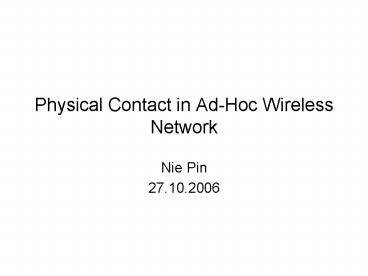Physical Contact in AdHoc Wireless Network - PowerPoint PPT Presentation
Title:
Physical Contact in AdHoc Wireless Network
Description:
Initial setup of a security association among two or more devices for subsequent ... Demonstrative Identification (DI) Authentication and confirmation ... – PowerPoint PPT presentation
Number of Views:40
Avg rating:3.0/5.0
Title: Physical Contact in AdHoc Wireless Network
1
Physical Contact in Ad-Hoc Wireless Network
- Nie Pin
- 27.10.2006
2
Agenda
- Introduction
- Assumptions on Ad-Hoc Wireless Network during the
First Connect - Constraints on mobile devices
- Attack Models
- Principles of Physical Contact
- Out-Of-Band (OOB) solutions
- Evaluation
- Conclusion
3
Introduction
- First Connect
- Initial setup of a security association among two
or more devices for subsequent secure
communication. Typical case pairing of two
devices, agreement signing between two parties. - Physical Contact
- Negotiating and exchanging process within a
limited scope, between two parties. (OOB) - Basic perceivability of the surroundings (users
role) - Out of Band (OOB)
- A separate communicating band (auxiliary channel)
other than the one used for the subsequent
communications, for exchanging security
parameters (e.g. transmitting authentication
data) or control information
4
Assumptions
- Direct talk
- One-to-One communication style
- Demonstrative Identification (DI)
- Authentication and confirmation
- Limit the control range, reduce interferences
- No trusted third party
- No valid assertion, token, rumor and
recommendation - No previous context
- No history and experience
- Security Transient Association
- Not necessary, but likely in practice, better to
include
5
Constraints
- User Interface
- Input
- Keypad, handwriting, microphone, camera,
biometric detectors - Output
- Sticker (i.e. label), LED, beeper, LCD display
- Computing Power and Memory
- Weak CPU (Intel PXA255 400MHz, bus 200MHz)
- Little memory (HP iPAQ Pocket PC 2215 96MB,
Nokia 6822 3.5MB internal memory) - Battery Consumption
- Limited on electrical power (Nokia N95 Talk
time2.5-3.5 hours, PDA Talk time4-6 hours)
6
Attack Models
- Active Attacks
- Denial-of-Service (DoS) attack
- Block the target by flooding it with numerous
requests - Considering the battery limit, it turns to be
sleep deprivation torture. - Interference attack
- Create too much strong noises to disable the
detection at the receivers side - Man-in-the-middle (MITM) attack
- Modifying data streams, inserting and deleting
(break the integration) - Playback of data, e.g. reflection attack and
replay attack. - Passive Attacks
- Eavesdropping, a step for further attacking
7
Principles of Physical Contact
- Bootstrap
- Imprinting, what should be bound or exchanged for
subsequent secure communication? - Proximity Detection
- Fulfill the DI requirement
- Presence Confirmation
- Derive from DI
- Capture intention and set location restriction
- Pre-authentication
- Control Information or security factors exchange
by using OOB - Flexibility
- The solution can be carried out in many forms or
OOBs to fit the constraints of different devices
8
Out-Of-Band (OOB) solutions
- Authenticated Strings
- Use commitment schemes to exchange the
commitment, containing the keys and a hidden
value - Strings/numeric Comparison or Passkey-based
- User acknowledges the check values on both
devices or input the value (a shared secret) to
the other devices - Human knowledge based
- Radio, Infrared and ultrasound
- Special transmitter and receiver for the channel
- Location limited channel (LLC) distance binding
- Closest proximity assumption is the necessary
condition - Visual Channel
- Camera needed, display (e.g. LCD or LED) needed
- Computing intensive analyzing algorithms
- Two examples SiB and VIC (DH-IC)
- Audio Channel
- LC with the same basic idea as SiB
- Biometrics Channel
- E.g. Grip pattern, fingerprint, voice spectrum
9
Evaluation
- Advantages
- Benefits
- Pre-authentication, DI, MitM attack prevention
- Flexibility
- Unidirectional authentication and mutual
authentication - Disadvantages
- Algorithms complexity
- E.g. image processing, light signals processing,
distance measurement, Integrity verification - Extra assumptions or overhead on devices and
environment - Channel carrier (e.g. transmitter, receiver,
detector or camera, LED)
10
Evaluation (2)
- Human knowledge / biometric based
- Simple, but needs user operation (e.g. compare or
input) as the auxiliary authentication channel - Radio, infrared and ultrasound
- Fool prove
- High requirement on distance measuring
- Special modules needed on the devices
- Visual channel
- Easy to use
- Algorithm complex and computing intensive
11
Conclusion
- Balancing game
- Tradeoff between usability (human involved
degree) and complexity (algorithms simulate human
perceivability, e.g. seeing, touching, feeling) - Tradeoff between security and efficiency,
execution time (e.g. integrity verification) - Fitting specific situations (applications scope)
- One way authentication for ad-hoc services in
public places - Lower the requirements on SPs equipments (e.g.
SCgtPasskey, SiBgtVIC) - Mutual authentication for peer-to-peer
communications - Make full use of popular equipments or functions
on mobile devices (e.g. SC, SiB)
12
Acknowledgement
- Thanks for the comments and suggestions from
Prof. K. Nyberg , Prof. N. Asokan, Jukka Valkonen
and Vesa Vaskelainen ?































